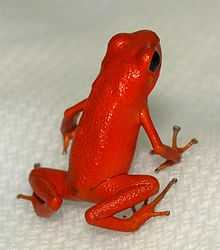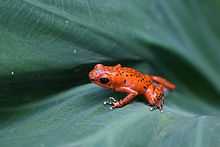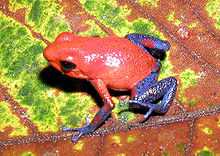Strawberry poison-dart frog
| Oophaga pumilio | |
|---|---|
 | |
| Conservation status | |
| Scientific classification | |
| Kingdom: | Animalia |
| Phylum: | Chordata |
| Class: | Amphibia |
| Order: | Anura |
| Family: | Dendrobatidae |
| Genus: | Oophaga |
| Species: | O. pumilio |
| Binomial name | |
| Oophaga pumilio (Schmidt, 1857) | |
| Synonyms | |
|
Dendrobates pumilio Schmidt, 1857 | |
The strawberry poison frog or strawberry poison-dart frog (Oophaga pumilio, formerly Dendrobates pumilio) is a species of small poison dart frog found in Central America.[2] It is common throughout its range, which extends from eastern central Nicaragua through Costa Rica and northwestern Panama. The species is often found in humid lowlands and premontane forest, but large populations are also found in disturbed areas such as plantations.[3] The strawberry poison frog is perhaps most famous for its widespread variation in coloration, comprising approximately 15–30 color morphs, most of which are presumed to be true-breeding.[4] O. pumilio, while not the most poisonous of the dendrobatids, is the most toxic member of its genus.
Diet
The diet of O. pumilio causes the skin of the amphibian to become toxic in nature when certain subspecies of mites and ants are ingested.[5][6] Alkaloid toxins are organic in nature and contain nitrogenous bases that react with carbon and hydrogen groups.[7] Pumiliotoxin 251D is the specialized toxin that is sequestered by this species of frog. This toxin has a negative stimulating effect on cardiac function and is a severe disruptor of the sodium potassium ion channels within cells. Upon ingestion of Pumiliotoxin 251D, organisms preying on O. pumilio experience convulsions, paralysis, and death.[7]
Oribatida mites belonging to the glandulate suborder Brachypylina are an important origin of pumiliotoxins in O. pumilio. Hexane-extraction techniques indicate presence of alkaloid toxins in Brachypylina.[8] Toxins appear to be biosynthesized in adult mites, as nymph and larval stages of the insect do not carry the toxins. Experimental analysis of this species of mite show alkaloid toxins are found almost exclusively in the opisthonotal glands of mites of the Scheloribatidae.[9] Oil glands of the mite contain the toxins and are then released internally as the amphibian digests the insect.
_(2532163201).jpg)
O. pumilio can also attribute its cutaneous toxicity to its rich diet of formicine ants.[10] Species of the formicine genus Brachymyrmex contain pumiliotoxins which the frogs incorporate and accumulate poison from.[11] There is a variability of alkaloid profiles among populations and individuals of O. pumilio, which is indicative of varying levels of available prey within their intraspecific habitats.[12] Research and physical analysis reveal that maternally derived alkaloids exist in young tadpoles.[13] During tadpole-rearing, mother frogs feed their young an unfertilized egg from their ovaries after dropping each individual tadpole into a repository of water usually found in a bromeliad.[14] Tadpoles lacking the obligate nutritive egg diet do not contain the alkaloid.[13] This step is crucial for the tadpoles to sequester the alkaloid from their mother; without such, young tadpoles become susceptible to predation by arthropods and other frogs.
Behavior
Oophaga pumilio is diurnal and primarily terrestrial, and can often be found in leaf litter in both forested and disturbed areas. Though brightly colored and toxic, these frogs are relatively small, growing to approximately 17.5–22 mm (0.69–0.87 in) in standard length.[3] Males are extremely territorial, guarding small territories;[15] females and juveniles are far more sociable.
 |
Listen to a pumilio call
Male advertisement call |
| Problems playing this file? See media help. | |
Reproduction and parental care
Oophaga pumilio is an external breeder, and other species of the genus Oophaga are notable in the amphibian world for exhibiting a high degree of parental care.[16] The strawberry poison frog has dual parental care.[17] The males defend and water the nests, and the females feed the oophagous tadpoles their unfertilized eggs. Although both sexes contribute to parental care, females invest more heavily in terms of energy expenditure, time investment, and loss of potential reproduction.[17] Females provide energetically costly eggs to the tadpoles for 6–8 weeks (until metamorphosis), remain sexually inactive during tadpole rearing, and care for only one clutch of four to six tadpoles at a time.[17] The males, though, contribute the relatively "cheap" (in terms of energy) act of watering and protecting the eggs for a relatively short period (10–12 days), and can care for multiple nests at one time.[17] The extreme maternal investment in their offspring is believed to be the result of high egg mortality. Only 5–12% of the clutch develops into tadpoles, so the female's fitness may be best increased by making sure those few eggs that form tadpoles survive.[18]

After mating, the female lays three to five eggs on a leaf or bromeliad axil. The male then ensures the eggs are kept hydrated by transporting water in his cloaca. After about 10 days, the eggs hatch and the female transports the tadpoles on her back to some water-filled location.[19] In captivity, on rare occasions, the male is observed transporting the tadpoles, though whether this is intentional, or the tadpoles simply hitch a ride, is unknown. Bromeliad axils are frequently used tadpole deposition sites, but anything suitable can be used, such as knots in trees, small puddles, or human trash such as aluminum cans.
Tadpoles are deposited singly at each location. Once this has been done, the female will come to each tadpole every few days and deposit several unfertilized food eggs.[3] In captivity, tadpoles have been raised on a variety of diets, ranging from algae to the eggs of other dart frogs, but with minimal success. O. pumilio tadpoles are considered obligate egg feeders, as they are unable to accept any other form of nutrition.
After about a month, the tadpole will metamorphose into a small froglet. Generally, it stays near its water source for a few days for protection as it absorbs the rest of its tail.
Taxonomy
Oophaga pumilio belongs to the genus Oophaga,[16] although the name Dendrobates pumilio is still sometimes used. There is evidence that the species of the Oophaga genus (previously classified as the "female parental care group" of Dendrobates[20]) are a monophyletic evolutionary group. Due to the low level of genetic divergence between the species analyzed in this genus, it is estimated that they speciated relatively recently, after the formation of the current Panamanian land bridge in the Pliocene (3–5 million years ago).[21] Oophaga pumilio is believed to be most closely related to Oophaga arborea.[22]
Evolution
Strawberry poison frog, Oophaga pumilio, shows extreme variation in color and pattern between populations that have been geographically isolated for more than 10,000 years. [23] When populations are separated by geographic distances and landscape barriers, they frequently experience restricted gene flow, which can enable phenotypic divergence between populations through selection or drift . [24] Their variety in warning coloration is used for their visibility, toxicity and resistance to predators. When divergent phenotypes are mostly restricted to separate islands, the biogeography of color polymorphism suggests a major role for neutral process. However, Summers et al. (1997) [25]provide evidences that neutral divergence alone is unlikely to have caused the variation in color patterns. Based on Lande’s find, rapid evolution in sexually selecting species is led by the interaction of random genetic drift with natural and sexual selection such as random genetic drift in female mating preferences. [26] Color is known to play a role in male–female signaling, mate attraction, and male–male signaling in anurans. Based on Tazzyman and Iwasa’s study that involved collections of samples from main islands in the Bocas del Toro archipelago, its results proved that female preference on male calls led to call divergence and therefore divergence was driven by sexual selection. Mate choice plays a critical role in generating and maintaining biodiversity. [27] Furthermore, spatial variation in predators or habitat features could exert divergent natural selection on coloration in response to its subjection to predator selection. [28] It is still unclear to what extent sexual selection has driven the evolution of color morphs rather than reinforcing the reproductive isolation of morphs. [29]In an aposematic organism such as Oophaga pumilio, we cannot attribute a phylogenetic signal of selection to female mate choice alone but is quite possible that genetic drift would interact with female color preferences to trigger divergence [30]

Captivity
Oophaga pumilio is a popular frog in captivity, due to its striking colors and unique life cycle. They have been imported in vast quantities to the United States and Europe since the early 1990s, when they would typically be available for around US$30 each. However, these shipments have since stopped, and O. pumilio is much less common and available in reduced diversity. In Europe, O. pumilio is much more diverse and available due to an increased frequency of smuggling and the resulting offspring of smuggled animals. Smuggling of dart frogs is less common elsewhere, but still problematic as it kills large numbers of animals and frequently degrades or destroys viable habitat.
Recently, O. pumilio has been exported from Central America again in small numbers from frog farms. Because of this, they have seen a huge increase in numbers in the dart frog community and are regularly available.
Common color morphs in captivity

One example of a color morph is the blue jeans morph. It is most common throughout the species range, but is relatively rare in the United States pet trade. Most of these animals came from imports during the 1990s, or are their descendants. This morph can be found throughout Costa Rica, as well as mainland Panama.[4]
References
- ↑ Solís, F., Ibáñez, R., Jaramillo, C., Chaves, G., Savage, J., Köhler, G. & Cox, N.A. (2010). "Oophaga pumilio". IUCN Red List of Threatened Species. Version 2014.2. International Union for Conservation of Nature. Retrieved 12 September 2014.
- ↑ Frost, Darrel R. (2014). "Oophaga pumilio (Schmidt, 1857)". Amphibian Species of the World: an Online Reference. Version 6.0. American Museum of Natural History. Retrieved 12 September 2014.
- ↑ 3.0 3.1 3.2 Savage, J. M. 2002. The Amphibians and Reptiles of Costa Rica. University of Chicago Press, Chicago and London.
- ↑ 4.0 4.1 Summers, K., Cronin, T.W. and Kennedy, T. 2003. Variation in spectral reflectance among population of Dendrobates pumilio, the strawberry poison frog, in the Bocas del Toro Archipelago, Panama. Journal of Biogeography 30:35-53.
- ↑ Saporito, Ralph; Donnelly, Maureen; Norton, Roy; Garraffo, Martin; Spande, Thomas; Daly, John (2007). "Oribatid Mites as a Major Dietary Source for Alkaloids in Poison Frogs". Proceedings of the National Academy of Sciences in the United States of America 104: 8885–8890. doi:10.1073/pnas.0702851104. PMC 1885597. PMID 17502597.
- ↑ Saporito, Ralph; Garraffo, Martin; Donnelly, Maureen; Edwards, Adam; Longino, John; Daly, John (2004). "Formicine Ants: An Arthropod Source for the Pumiliotoxin Alkaloids of Dendrobatid Poison Frogs". Proceedings of the National Academy of Sciences of the United States of America 101: 8045–8050. doi:10.1073/pnas.0402365101. PMC 419554. PMID 15128938.
- ↑ 7.0 7.1 Vandendriessche, T., Abdel-Mottaleb, Y., Maertens, C., Cuypers, E., Sudau, A., Nubbemeyer, U., Mebs, D., Tytgat, J. (2008). "Modulation of voltage-gated Na+ and K+ channels by pumiliotoxin 251D: A "joint venture" alkaloid from arthropods and amphibians". Toxicon 51 (3): 334–344. doi:10.1016/j.toxicon.2007.10.011.
- ↑ Takada, W., Sakata, T., Shimano, S., Enami, Y., Mori, N., Nishida, R., and Kuwahara, Y. (2005). "Scheloribatid mites as the source of pumiliotoxins in dendrobatid frogs". Journal of Chemical Ecology 31 (10): 2403–2415. doi:10.1007/s10886-005-7109-9. PMID 16195851.
- ↑ Raspotnig, G., Norton, R.A., Heethoff, M. (2011). "Oribatid mites and skin alkaloids in poison frogs". Biology Letters 7 (4): 555–556. doi:10.1098/rsbl.2010.1113.
- ↑ Saporito, Ralph; Garraffo, Martin; Donnelly, Maureen; Edwards, Adam; Longino, John; Daly, John (2004). "Formicine Ants: An Arthropod Source for the Pumiliotoxin Alkaloids of Dendrobatid Poison Frogs". Proceedings of the National Academy of Sciences of the United States of America 101: 8045–8050. doi:10.1073/pnas.0402365101. PMC 419554. PMID 15128938.
- ↑ Staudt, K., Meneses, O., S., Mebs, D., Proehl, H. (2010). "Foraging behaviour and territoriality of the strawberry poison frog (Oophaga pumilio) in dependence of the presence of ants". Amphibia-Reptilia 31 (2): 217–227. doi:10.1163/156853810791069100.
- ↑ Mebs, D., Pogoda, W., Batista, A., Ponce, M., Koelher, G., Kauert, G. (2008). "Variability of alkaloid profiles in Oophaga pumilio (Amphibia: Anura: Dendrobatidae) from Western Panama and Southern Nicaragua". Salamandra 44 (4): 241–247.
- ↑ 13.0 13.1 Stynoski, J. L.; Torres-Mendoza, Y.; Sasa-Marin, M.; Saporito, R. A. (2014). "Evidence of maternal provisioning of alkaloid-based chemical defenses in the strawberry poison frog Oophaga pumilio". Ecology 95 (3): 587–593. doi:10.1890/13-0927.1. PMID 24804437.
- ↑ Forsyth, A., Fogden, M., Fogden, P., Wilson, E., O. 2008. Nature of the Rainforest: Costa Rica and Beyond. Cornell University Press. Ithaca, New York, USA.
- ↑ Donnelly, M. A. 1989. Reproductive phenology and age structure of Dendrobates pumilio in northeastern Costa Rica. Journal of Herpetology, 23:362-367.
- ↑ 16.0 16.1 Grant, T., Frost, D. R., Caldwell, J. P., Gagliardo, R., Haddad, C. F. B., Kok, P. J. R., Means, D. B., Noonan, B. P., Schargel, W. E., and Wheeler, W. C. (2006). "Phylogenetic systematics of dart-poison frogs and their relatives (Amphibia: Athesphatanura: Dendrobatidae)" (PDF). Bulletin of the American Museum of Natural History 299: 1–262. doi:10.1206/0003-0090(2006)299[1:PSODFA]2.0.CO;2.
- ↑ 17.0 17.1 17.2 17.3 Haase, A., and H. Prohl. 2002. Female activity patterns and aggressiveness in the strawberry poison frog Dendrobates pumilio (Anura: Dendrobatidae). Amphibia-Reptilia 23: 129-140.
- ↑ Prohl, H., and W. Hodl. 1999. Parental investment, potential reproductive rates, and mating system in the strawberry dart-poison frog, Dendrobates pumilio. Behavioral Ecological Sociobiology 46: 215-220
- ↑ Limerick, S (1980). "Courtship behavior and oviposition of the poison-arrow frog Dendrobates pumilio". Herpetologica 36: 69–71.
- ↑ Zimmermann, H. and Zimmermann, E. 1988. Etho-Taxonomie und zoogeographische Artengruppenbildung bei Pfeilgiftfröschen (Anura: Dendrobatidae). Salamandra 24:125-160.
- ↑ Summers, K., Weigt, L.A., Boag, P., and Bermingham, E. 1999. The evolution of female parental care in poison frogs of the genus Dendrobates: Evidence from mitochondrial DNA sequences. Herpetologica 55(2):254-270.
- ↑ Roberts, J.L., Brown, J.L., von May, R., Arizabal, W., Presar, A., Symula, R., Schulte, R., and Summers, K. 2006. Phylogenetic relationships among poison frogs of the genus Dendrobates (Dendrobatidae): A molecular perspective from increased taxon sampling. Herpetological Journal 16:377-385.
- ↑ Brown, J; Maan, M; Cummings, M; Summers, K (2010). "Evidence for selection on coloration in a Panamanian poison frog: a coalescent-based approach". Journal of Biogeography 37: 891–901. doi:10.1111/j.1365-2699.2009.02260.x.
- ↑ Wang, I; Summers, K (2010). "Genetic structure is correlated with phenotypic divergence rather than geographic isolation in the highly polymorphic strawberry poison-dart frog". Molecular Ecology, 19: 447–458. doi:10.1111/j.1365-294x.2009.04465.x.
- ↑ Summers, K; Bermingham, E; Weigt, L; McCafferty, S; Dahlstrom, L (1997). "Phenotypic and genetic divergence in three species of dart-poison frogs with contrasting parental behavior". The Journal of Heredity 88.
- ↑ Tazzyman, I; Iwasa, Y (2010). "Sexual selection can increase the effect of random genetic drift--a quantitative genetic model of polymorphism in Oophaga pumilio, the strawberry poison-dart frog". Evolution; International Journal of Organic Evolution 64 (6): 1719–1728. doi:10.1111/j.1558-5646.2009.00923.x. PMID 20015236.
- ↑ Reynolds, R; Fitzpatrick, B (2007). "ASSORTATIVE MATING IN POISON-DART FROGS BASED ON AN ECOLOGICALLY IMPORTANT TRAIT". Evolution 61 (9): 2253–2259. doi:10.1111/j.1558-5646.2007.00174.x. PMID 17767594.
- ↑ Brown, J; Maan, M; Cummings, M; Summers, K (2010). "Evidence for selection on coloration in a Panamanian poison frog: a coalescent-based approach". Journal of Biogeography 37: 891–901. doi:10.1111/j.1365-2699.2009.02260.x.
- ↑ Wang, I; Shaffer, H (2008). "Rapid color evolution in an aposematic species: a phylogenetic analysis of color variation in the strikingly polymorphic strawberry poison-dart frog". Evolution 62 (11): 2742–2759. doi:10.1111/j.1558-5646.2008.00507.x. PMID 18764916.
- ↑ Brown, J; Maan, M; Cummings, M; Summers, K (2010). "Evidence for selection on coloration in a Panamanian poison frog: a coalescent-based approach". Journal of Biogeography 37: 891–901. doi:10.1111/j.1365-2699.2009.02260.x.
- ↑ Reynolds, R; Fitzpatrick, B (2007). "ASSORTATIVE MATING IN POISON-DART FROGS BASED ON AN ECOLOGICALLY IMPORTANT TRAIT". Evolution 61 (9): 2253–2259. doi:10.1111/j.1558-5646.2007.00174.x. PMID 17767594.
- ↑ Summers, K; Bermingham, E; Weigt, L; McCafferty, S; Dahlstrom, L (1997). "Phenotypic and genetic divergence in three species of dart-poison frogs with contrasting parental behavior". The Journal of Heredity 88.
- ↑ Tazzyman, I; Iwasa, Y (2010). "Sexual selection can increase the effect of random genetic drift--a quantitative genetic model of polymorphism in Oophaga pumilio, the strawberry poison-dart frog". Evolution; International Journal of Organic Evolution 64 (6): 1719–1728. doi:10.1111/j.1558-5646.2009.00923.x. PMID 20015236.
- ↑ Wang, I; Shaffer, H (2008). "Rapid color evolution in an aposematic species: a phylogenetic analysis of color variation in the strikingly polymorphic strawberry poison-dart frog". Evolution 62 (11): 2742–2759. doi:10.1111/j.1558-5646.2008.00507.x. PMID 18764916.
- ↑ Wang, I; Summers, K (2010). "Genetic structure is correlated with phenotypic divergence rather than geographic isolation in the highly polymorphic strawberry poison-dart frog". Molecular Ecology, 19: 447–458. doi:10.1111/j.1365-294x.2009.04465.x.
- ↑ Brown, J; Maan, M; Cummings, M; Summers, K (2010). "Evidence for selection on coloration in a Panamanian poison frog: a coalescent-based approach". Journal of Biogeography 37: 891–901. doi:10.1111/j.1365-2699.2009.02260.x.
External links
| Wikispecies has information related to: Oophaga pumilio |
| Wikimedia Commons has media related to Oophaga pumilio. |
- Ask Questions and get answers from experts : Dart Frog Experts
- Amphibiaweb, Amphibiaweb entry for Oophaga pumilio
- Dendrobates.org, Information site for poison frogs
Media
- Oophaga pumilio at CalPhotos
